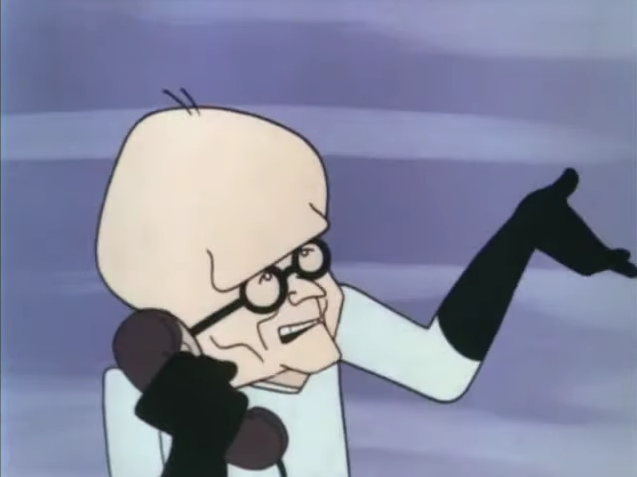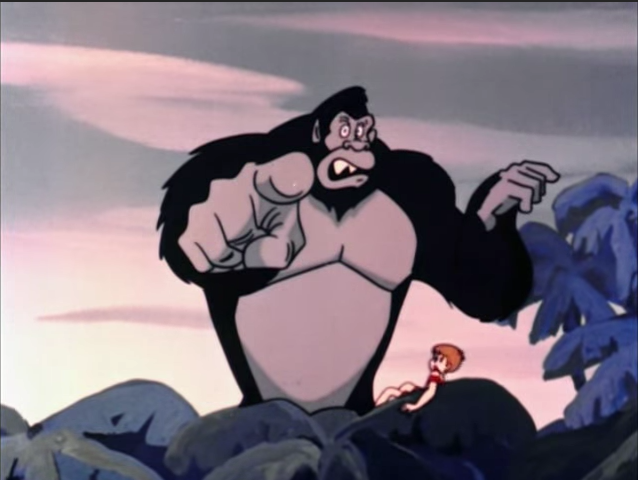
Considering that I wrote about Godzilla’s first failure of a foray into animated television, it only makes sense that I should do the same for his predecessor/rival, who managed to land a cartoon a decade before. But The King Kong Show, which aired 26 episodes from 1966-1969, is notable in a historical sense for a few reasons, some of which connect it to Godzilla almost directly. For one, this series was produced by Videocraft, the original name for Arthur Rankin and Jules Bass’ production company (back when they really only had Rudolph the Red-Nosed Reindeer to their name), in collaboration with Toei Animation in Japan, making this the first time an American cartoon was outsourced there. More importantly to kaiju fans, though, Rankin and Bass got the rights to make both a King Kong cartoon AND a movie, the latter of which they gave to Toho (who had produced King Kong vs. Godzilla a few years earlier), leading to both Godzilla vs. The Sea Monster (based on a rejected script) and King Kong Escapes, which is technically based on this series. There’s a lot of other interesting names attached this cartoon as well, including some prominent anime directors producing the shows, and American artists like Mad Magazine’s Jack Davis providing the designs (although I find it amusing that most sources indicate that Davis only designed “angry Kong”), and you should check out articles like this one and this one to learn more about that stuff, because you’re probably not going to get the idea that this show has any significance or that real talent was behind it from reading the rest of this post.
Okay, that’s a bit of an exaggeration—while this does share some style and format qualities with the other sixties cartoon I’ve covered, The Beatles (which it aired contemporaneously with, and they were sometimes even advertised side-by-side), those qualities actually do it some favours every once in a while. The King Kong Show exists in a strange liminal realm, between American and Japanese cartoons of the time, and between the limitations of sixties cartoons and the somehow even more strict limitations of seventies cartoons, and for that reason alone it’s actually kind of fascinating.
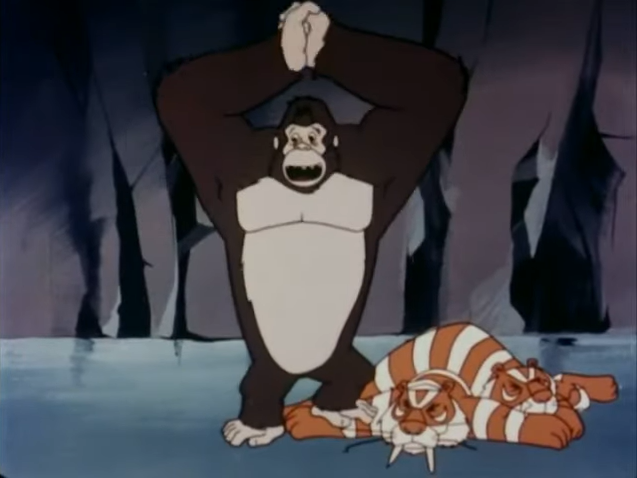
This interpretation of Kong existed well into the period where the original movie and the ape himself was more or less the sole property of children (if the re-releases in the fifties and the monster magazines of the sixties didn’t make it so, then King Kong vs. Godzilla certainly did), and while Kong has had all ambiguity removed, he also has a surprisingly cute and appealing design, so there’s that. The set-up of the show has renowned scientist/negligent parent Professor Bond travel to Skull Island, sometimes called Mondo Island (which is what it’s called in King Kong Escapes), alongside his children Susan (who basically never raises her voice at any point, and also has to do all the cooking and cleaning despite being around fifteen—how about the grown-ass adult does that stuff instead?) and Bobby, and the latter ends up befriending Kong, who follows him around and listens to his every word. Another recurring character is Captain Englehorn, a transplant from the 1933 film, who in this version has a Popeye squint and an unidentifiable accent. The characters and their relationships with Kong are established in a pilot episode (which was aired at the end of the series, blast the vagaries of scheduling!) that also very loosely retells the plot of the original movie with animation that is, somehow, worse than the rest of the series. The characters on the show are all voiced by the ragtag Canadians who filled out Rankin & Bass’ early productions as well as shows like Spider-Man and Rocket Robin Hood, and includes Billie Mae Richards, voice of Rudolph, as Bobby.
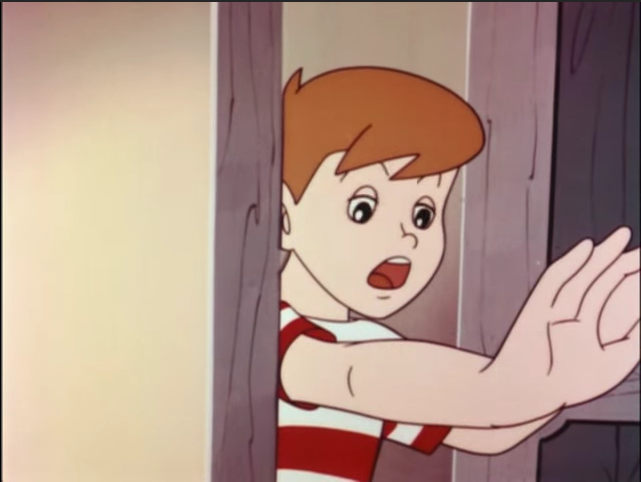
The standout character of the show, though, is its recurring antagonist, the mad scientist Dr. Who (look I know what you’re going to say, but cram it, nerds), who was one of the elements here that would also end up in the Toho movie, even if it’s only a very loose adaptation. I really like Dr. Who’s big-headed design (even though I recognize that he is basically just a take on Dr. Sivana from the old Captain Marvel comics), I like his voice, and I like the outlandishness of his various schemes, which includes melting the polar icecaps with a nuclear reactor (he flooded Anchorage! Anchorage!), attacking the Suez Canal with a giant Sphinx monster, and blowing stuff up with a solar energy collector. Despite the elaborate nature of these plans, he has an amusing tendency towards setting up incredibly blunt traps for his enemies, such as coming out of nowhere and threatening the Bonds with a shotgun, or creating a fake children’s home to lure them in, which he reveals as soon as they step inside. The fact that the family keeps falling for it over and over again mostly shows them to be incredibly oblivious—but Who also always assumes that Kong won’t easily ruin his plans, even though he does so every single time, so he’s not exactly the sharpest knife in the drawer, either. Also, in every episode, he has a completely different sidekick wearing a different funny hat. Honestly, each episode that he appeared in was made significantly more enjoyable by his presence (which is good, because I think he’s in every second episode), and so he deserves a place in my website’s personal rogues gallery alongside Rodak from The Space Giants, The Machine from Free Willy, and what’s-his-face Dimentia Five guy from Rocket Robin Hood.
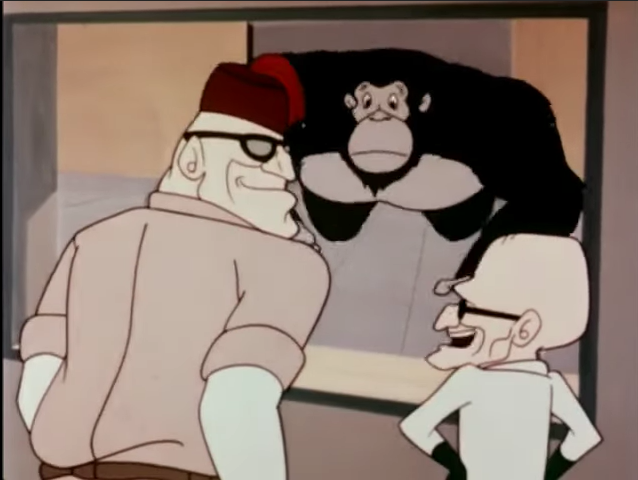
Here’s the good news: these cartoons are only seven minutes long, and they manage to have just as much happen in those seven minutes as in the full twenty-two of the Hanna-Barbera Godzilla, which is damning with faint praise, but it deserves all the faint praise I damn it with. The fact of the matter is, even if an episode is boring, it’s over before you know it, and I’ve now watched enough bad cartoons to take that brevity where I can get it. The original format of the show had two Kong cartoons grouped with another cartoon called Tom of THUMB, a secret agent parody that I read about, got to the part about “his Asian sidekick”, and said “An Asian sidekick character in a sixties cartoon? No thanks!”
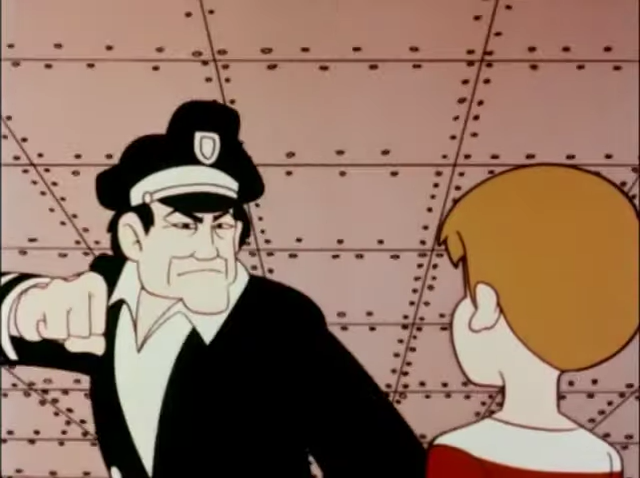
The shortness of each Kong episode (some of which take place on The Island Whose Name We Can’t Agree On, and some globetrotting exploits) means that things just sort of happen abruptly, which can emphasize many of the show’s quirks. The obvious one is that the solution to each crisis is usually “Bobby gets Kong to fix it”, which maybe makes things a tad predictable. Second, it makes the wooden animation even more noticeable, especially the characters’ disconcerting inability to emote, generally stuck with glassy-eyed stares (don’t even get me started on the inconsistency of Kong’s size, as they seemingly gave up keeping track within the show’s intro)—in hindsight, this series looks very much like old anime (up to and including its incredible stiffness), and barely even attempts to hide it, with some character designs looking right out of Astro Boy or things of a similar vintage. Finally, the relative rapidity of events also makes the weirder plot elements even weirder.
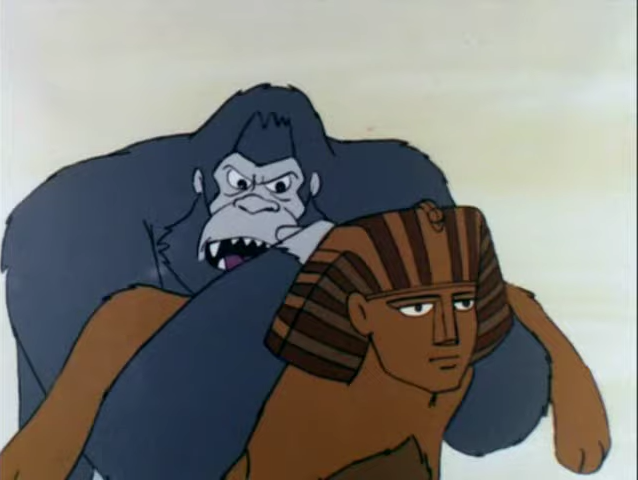
There are plenty of goofy storylines that are more or less standard for this sort of series—for example, they go to the Arctic when a pair of sabretooth tigers are discovered frozen the ice, only for them to escape when the guy thawing them out with a flamethrower somehow falls asleep in the middle of it. But if you think that The King Kong Show is just a series of giant monster battles, don’t worry, there’s also plenty of more mundane stories, such as the Bonds painting Kong up as a ghost to scare away some stubborn miners threatening their island, which only makes you wonder how quotidian a giant gorilla has to become before it has to pretend to be a ghost to scare people. Surprisingly, what ended up being the most surreal episode was one of the less action-packed ones, where Bobby becomes enamoured with Englehorn’s dog, which makes Kong jealous (a fact that Bobby is completely oblivious to until Susan rightfully dresses him down for it) and convinces him to try to lure the dog into the jungle where it can be picked off by one of several prehistoric monstrosities—until Kong has second thoughts and saves the dog from a giant bird wearing a hat(?) Many of those scenes are completely dialogue-free, and combined with the minimalist score and sound effects (in many episodes, things happen with no accompanying sound effects at all) and the deliberate pacing (plus some inexplicable editing), turns something that should be boring into a lot of “what exactly am I watching?”
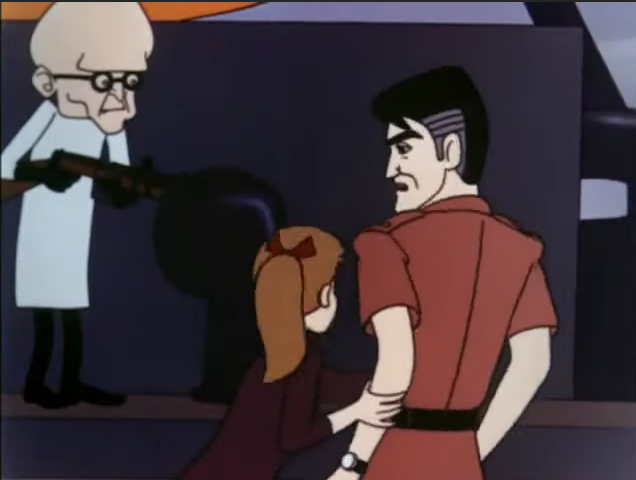
Probably the most unexpected thing about the show, though, is that quite unlike Godzilla, it’s allowed to have some actual violence and excitement, or at least as much excitement as this incredibly cheap animation style will allow. Kong not only gets into real fights with dinosaurs and other sundry creatures, but he straight up murders some of them. There’s even some blood in an episode where Professor Bond knifes a shark’s belly! In another notable episode, we are introduced to Mechani-Kong, the Dr. Who-piloted robot who would also be adapted into King Kong Escapes (with a very different design), and while the action is slow, it at least has some impact (although the most entertaining part of it is that none of the characters suspect that Dr. Who is involved despite that being the most obvious explanation—for a smart guy, Professor Bond sure is stupid.) Surprisingly, there are fight scenes in multiple episodes that are actually relatively acceptable in execution. I imagine this show is right on the cusp of when violence was phased out of Saturday morning cartoons, out of fear of organized parent group complaints, but I’m so used to sanitized stuff from this period that the modest level of it here honestly shocked me. You don’t realize how much you appreciate seeing a giant creature punch or smash another one until it’s taken away from you.
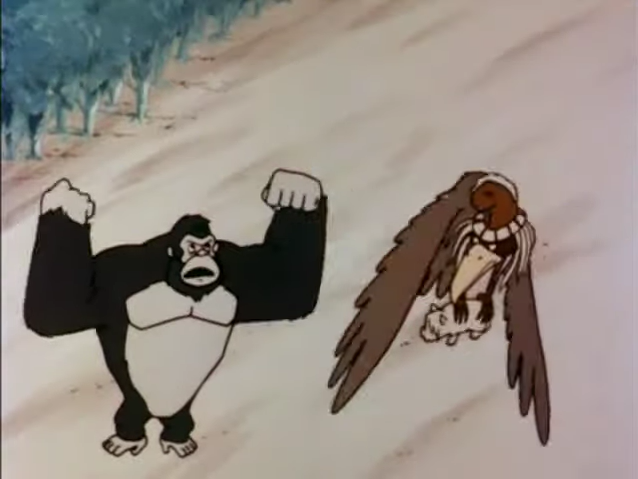
Look, even I’m surprised at how positive most of this post has been—The King Kong Show is definitely not clever or well-made on a writing or an animation level, but when contrasted with a lot of the garbage I’ve had to wade through in my lifelong quest to challenge my own sanity, this one went down surprisingly easy. At its worst, it’s forgettable—but every once in a while you’ll get a weird moment, a fun design, or a Dr. Who plot that is silly enough to keep my attention for all of seven minutes. Maybe I’m just getting soft in my old age, maybe I’m being generous because I’m just ape for giant apes in general, but in the battle of Godzilla vs. King Kong cartoons, Kong wins out, if not necessarily by an Empire State Building-sized amount.
BUT, IS THE THEME SONG CATCHY?: Aside from the bongo beat in the background, I found it kind of low energy and dirge-like. But I guess the lyrics are easy to follow, if a little dopey.
